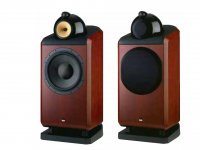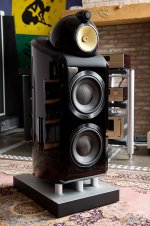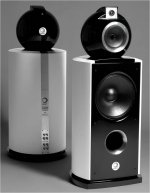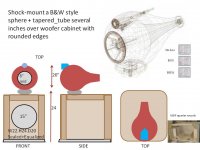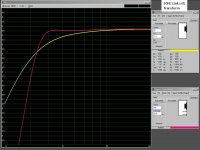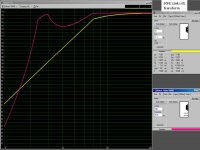I am looking to build a bass cabinet with two Beyma's 10BR60 per side.
Crossed to an almost full range Alpair 7.3
Powered by Rotel RMB1048 and MiniDSP 2x8
To look a little like the B&W 800D with a curved back panel.
I like sealed, and with two drivers more achievable however open to all suggestions.
Thanks
Crossed to an almost full range Alpair 7.3
Powered by Rotel RMB1048 and MiniDSP 2x8
To look a little like the B&W 800D with a curved back panel.
I like sealed, and with two drivers more achievable however open to all suggestions.
Thanks
Yours is a great design
Greetings,
IMO your idea is a great design (mostly since I have thought of it as well).
I can't find out much info on the 7.3, so my comments might have to be adjusted accordingly.
What I would do is, use your 2 drivers per side: Beyman 10 BR 60
in a ppsl bass cabinet and use the Alpair 's in an open baffle above
200Hz (or thereabouts, ONLY IF this driver is suitable for an open baffle design).
Build the entire assembly in a very sturdy fashion, and what you will accomplish is quite the reduction of that "dreaded box sound".
Also, if it were me, I'd use a vented bass cabinet and an active crossover system, but your choice of sealed could work as well, it just won't go as deep into the bass.
Greetings,
IMO your idea is a great design (mostly since I have thought of it as well).
I can't find out much info on the 7.3, so my comments might have to be adjusted accordingly.
What I would do is, use your 2 drivers per side: Beyman 10 BR 60
in a ppsl bass cabinet and use the Alpair 's in an open baffle above
200Hz (or thereabouts, ONLY IF this driver is suitable for an open baffle design).
Build the entire assembly in a very sturdy fashion, and what you will accomplish is quite the reduction of that "dreaded box sound".
Also, if it were me, I'd use a vented bass cabinet and an active crossover system, but your choice of sealed could work as well, it just won't go as deep into the bass.
Original thread located here
This is the idea, but with two woofers, and the curved back protruding up like the B&W
This is the idea, but with two woofers, and the curved back protruding up like the B&W
An externally hosted image should be here but it was not working when we last tested it.
PPSL is an interesting idea with that beyma, although i admit i dont know how it would turn out. Another idea i have wanted to try is a ripole 'sub' using a pair of bassguitar speakers. Maybe a ripole is worthy of note, if a dipole system is what you are seeking. If monopole is your poison then the choice is more difficult. The beyma seems flexible, suitable for both sealed and vented (just). Sealed is very tempting, and i myself like the sealed LF character, but for a sub id choose a vented box using a PR. The Qts is a tad high but a PR could level that out nicely and give very nice bass extension. I have not tried any of these, yet, but i will lol.
Beyma
Paper cone with a rubber surround. Looks like a decent little 10 inch woof 🙂
Does anyone know what the cone material is, in the Beyma 10BR60?
Sorry for the thread hijack 🙂
Paper cone with a rubber surround. Looks like a decent little 10 inch woof 🙂
Paper cone with a rubber surround. Looks like a decent little 10 inch woof 🙂
Good price and works well in a sealed box - very tempting.
calcs
I just ran some calcs, and I'm sorry to say a vented ppsl would require a rather large enclosure. Most likely, too large for those in domestic situations
with she who must be obeyed. I could have done it with my wife though, no problem🙂
The ppsl vented requires a NET NET 12.64 ft^3 however, it will get you 25 hz bass. Hoffmann lives on !!
PPSL is an interesting idea with that beyma, although i admit i dont know how it would turn out. Another idea i have wanted to try is a ripole 'sub' using a pair of bassguitar speakers. Maybe a ripole is worthy of note, if a dipole system is what you are seeking. If monopole is your poison then the choice is more difficult. The beyma seems flexible, suitable for both sealed and vented (just). Sealed is very tempting, and i myself like the sealed LF character, but for a sub id choose a vented box using a PR. The Qts is a tad high but a PR could level that out nicely and give very nice bass extension. I have not tried any of these, yet, but i will lol.
I just ran some calcs, and I'm sorry to say a vented ppsl would require a rather large enclosure. Most likely, too large for those in domestic situations
with she who must be obeyed. I could have done it with my wife though, no problem🙂
The ppsl vented requires a NET NET 12.64 ft^3 however, it will get you 25 hz bass. Hoffmann lives on !!
How big for sealed?
56 litre for a box Q of 8 or 85 litre for a box Q of 7. I'd go for somewhere in the middle and fully stuff with either fibreglass or wool based loft insulation. Fully stuffed will bring the Q down a bit.
I'm thinking of getting a pair of these drivers myself.
for a sub I like the vented option better myself (and I see the OP has been sniffing around vented Beyma 10BR60 threads 😀
From that thread 55litres works ok
from my workings 65 litres tuned to 24 hertz gives a nicish F3 of 40 hz. 120 litres is way better though!
prime candidate for either sealed (~55 litres) or isobaric vented in 60-90 litres, F3 30hz and 24hz respectively
the only thing i dont like is the high group delay in isobaric vented alignment---and in reality the group delay may/may not matter to the user
From that thread 55litres works ok
from my workings 65 litres tuned to 24 hertz gives a nicish F3 of 40 hz. 120 litres is way better though!
prime candidate for either sealed (~55 litres) or isobaric vented in 60-90 litres, F3 30hz and 24hz respectively
the only thing i dont like is the high group delay in isobaric vented alignment---and in reality the group delay may/may not matter to the user
Last edited:
"Tastes Great" ... "Less Filling"
Selecting a speaker is just like selecting a beer!
"Sounds Great" ... "Less Room Filling"
"Orgasmic Sound in a Sexy Package" = BIG SUCCESS!
The first B&W Nautilus 801 speaker used a single 15" woofer because the company engineers found that a single large woofer sounds better than a couple of small woofers.(below). The best selling and most advertised B&W Nautilus uses two 10" woofers because the design performs well and looks sexy.
YOU ALREADY KNOW THAT:
---A single 15" woofer in a sealed cabinet with electronic Xover and room equalization will sound best. (+ Geddes Swarm)
---A sexy package would use two 10" woofers in a sealed cabinet with electronic Xover and room equalization.
---A sexy generic single-amp speaker would use two 10" woofers in a ported cabinet with passive Xover, plus a couple attenuation twist knobs.
---A three way speaker is required to approach 20-20Khz orgasmic sound. Ya need a tweeter... like B&W, Epison, etc... like SB29RDCN
==========
B&W Whitepaper on Bass
Advantages of Producing a Coherent Wavefront
One remarkable fact was consistently noticed during the development of the new 380mm bass unit for the Nautilus™801, and that was that a single large and stiff bass cone always sounded better than a number of smaller cones, even though they may well have had the same aggregated properties. One possible explanation for this is the concept of the production of a “coherent wave front”. This will be produced by a single large very stiff cone, which can couple with the air in a uniform manner over the whole of its surface area unaffected by differences in loading over that area. This behaviour is to be compared with that of several cones which, even though they may be closely spaced, will still leave gaps of “uncoupled air” between them. The very stiff cone material of the large single driver, which is a thick sandwich of Kevlar® reinforced paper fibers with a very stiff skin, makes it less responsive to local changes of acoustic impedance or unbalanced modal pressures either behind or in front of the cone.
A “coherent wavefront” simply means there is either a constant or a smoothly changing phase relationship between neighboring parts of the wavefront. So even if two drivers are relatively close together compared to a wavelength. Also, even if their contributions are equivalent to a single large driver, their different acoustic environments will mean that their outputs are slightly different, in terms of both amplitude and phase.
Furthermore, the air between the drive units is not being driven at all and this will translate into a change in phase across the resulting wavefront as the air tries to “fill in” the lost contribution. One can postulate that, at low frequencies, air can “spill off the edges” of the individual cones more easily in an array of small cones, which obviously have more edges for it to spill off, than from a single large one. For instance, two 12 inch drivers have a combined circumference of 1630mm whereas one 15 inch cone has a circumference of only 1037 mm. It is also interesting to note in this context that the radiation resistance and reactance at low frequencies of one 15 inch cone, is actually larger than that of two 12 inch cones, even though the area of the 15 inch cone is 0.02m2 smaller than two 12 inch cones. This is because the change from a steadily rising radiation resistance characteristic at low frequencies, to a horizontal one at high frequencies, occurs at a lower frequency with one large driver than with two smaller ones . Mutual radiation impedance effects will redress this imbalance to some extent, provided that the two individual drivers are close enough together for one driver to acoustically load the other, though it will only be totally redressed if the array of small drivers produces a totally contiguous surface in all directions.
============
Worth a few minutes of study: modern wide BW 8" vocal range midbass with 10gram Mms (example Epison)
WIKI:
Vocal_range is the measure of the breadth of pitches that a human voice can phonate. The most common application of the term "vocal range" is within the context of singing, where it is used as one of the major defining characteristics for classifying singing voices into groups known as voice types.
In terms of frequency, human voices are roughly in the range of 80 Hz to 1100 Hz (that is, E2 to C6) for normal male and female voices together.
Fundamental Speech frequency
The voiced speech of a typical adult male will have a fundamental frequency from 85 to 180 Hz, and that of a typical adult female from 165 to 255 Hz.
Selecting a speaker is just like selecting a beer!
"Sounds Great" ... "Less Room Filling"
"Orgasmic Sound in a Sexy Package" = BIG SUCCESS!
The first B&W Nautilus 801 speaker used a single 15" woofer because the company engineers found that a single large woofer sounds better than a couple of small woofers.(below). The best selling and most advertised B&W Nautilus uses two 10" woofers because the design performs well and looks sexy.
YOU ALREADY KNOW THAT:
---A single 15" woofer in a sealed cabinet with electronic Xover and room equalization will sound best. (+ Geddes Swarm)
---A sexy package would use two 10" woofers in a sealed cabinet with electronic Xover and room equalization.
---A sexy generic single-amp speaker would use two 10" woofers in a ported cabinet with passive Xover, plus a couple attenuation twist knobs.
---A three way speaker is required to approach 20-20Khz orgasmic sound. Ya need a tweeter... like B&W, Epison, etc... like SB29RDCN
==========
B&W Whitepaper on Bass
Advantages of Producing a Coherent Wavefront
One remarkable fact was consistently noticed during the development of the new 380mm bass unit for the Nautilus™801, and that was that a single large and stiff bass cone always sounded better than a number of smaller cones, even though they may well have had the same aggregated properties. One possible explanation for this is the concept of the production of a “coherent wave front”. This will be produced by a single large very stiff cone, which can couple with the air in a uniform manner over the whole of its surface area unaffected by differences in loading over that area. This behaviour is to be compared with that of several cones which, even though they may be closely spaced, will still leave gaps of “uncoupled air” between them. The very stiff cone material of the large single driver, which is a thick sandwich of Kevlar® reinforced paper fibers with a very stiff skin, makes it less responsive to local changes of acoustic impedance or unbalanced modal pressures either behind or in front of the cone.
A “coherent wavefront” simply means there is either a constant or a smoothly changing phase relationship between neighboring parts of the wavefront. So even if two drivers are relatively close together compared to a wavelength. Also, even if their contributions are equivalent to a single large driver, their different acoustic environments will mean that their outputs are slightly different, in terms of both amplitude and phase.
Furthermore, the air between the drive units is not being driven at all and this will translate into a change in phase across the resulting wavefront as the air tries to “fill in” the lost contribution. One can postulate that, at low frequencies, air can “spill off the edges” of the individual cones more easily in an array of small cones, which obviously have more edges for it to spill off, than from a single large one. For instance, two 12 inch drivers have a combined circumference of 1630mm whereas one 15 inch cone has a circumference of only 1037 mm. It is also interesting to note in this context that the radiation resistance and reactance at low frequencies of one 15 inch cone, is actually larger than that of two 12 inch cones, even though the area of the 15 inch cone is 0.02m2 smaller than two 12 inch cones. This is because the change from a steadily rising radiation resistance characteristic at low frequencies, to a horizontal one at high frequencies, occurs at a lower frequency with one large driver than with two smaller ones . Mutual radiation impedance effects will redress this imbalance to some extent, provided that the two individual drivers are close enough together for one driver to acoustically load the other, though it will only be totally redressed if the array of small drivers produces a totally contiguous surface in all directions.
============
Worth a few minutes of study: modern wide BW 8" vocal range midbass with 10gram Mms (example Epison)
WIKI:
Vocal_range is the measure of the breadth of pitches that a human voice can phonate. The most common application of the term "vocal range" is within the context of singing, where it is used as one of the major defining characteristics for classifying singing voices into groups known as voice types.
In terms of frequency, human voices are roughly in the range of 80 Hz to 1100 Hz (that is, E2 to C6) for normal male and female voices together.
Fundamental Speech frequency
The voiced speech of a typical adult male will have a fundamental frequency from 85 to 180 Hz, and that of a typical adult female from 165 to 255 Hz.
Attachments
2x10" per side, with active XO and a 15" to handle the really low?
There are datasheets for Beyma 10BR60(fs=42Hz) and 10BR60V2(fs=31Hz). The 6 to 6.5mm Xmax will set the deep bass limit, especially with a small volume sealed box compared to a much larger ported box. Even with Xmax=6mm, putting two 10BR60 into a 75 liter sealed box with a 30Hz Linkwitz transform will produce near 100db SPL down to 30Hz, even before room gain. Putting two 10BR60 into a much larger 160 liter ported box allows much higher max SPLs until the normal port drop near resonance to 106 db max SPLs near 30Hz. Adding a 15" woofer at a later date might deliver good value in improving bass room modes, in addition to some basic deep bass extension.
75 liter(2.65 ft3) sealed vs. 160 liter (5.64 f3) ported is a large difference in room appearance.
Attachments
Would anyone care to share their winISD Beyma model or Alpair 7.3?
Finally got my miniDSP 2x8 up and running. Using it simply as a pre-amp for now, but will hopefully get to use its full potential. I also purchased the UMIK-1 calibration mic, so hopefully any room anomalies and lumps and bumps can be sorted out on the digital XO end.
So to max out the credit card with 4 Beyma's or not...?
Finally got my miniDSP 2x8 up and running. Using it simply as a pre-amp for now, but will hopefully get to use its full potential. I also purchased the UMIK-1 calibration mic, so hopefully any room anomalies and lumps and bumps can be sorted out on the digital XO end.
So to max out the credit card with 4 Beyma's or not...?
As I now have a heathly stockpile of a few drivers here and there, and my Alpairs are sitting happy, I thought I may try Open Baffle with the beyma's to see how well they work.
Anyone done this with them? Any tips for implementing a good design.
My room is about 6m x 6m and room to play with placement.
Anyone done this with them? Any tips for implementing a good design.
My room is about 6m x 6m and room to play with placement.
2x 10" per side?
Or 4/5 spread out across the room ala Gedlee Swarm.
All active with dsp and mic for calibration
Or 4/5 spread out across the room ala Gedlee Swarm.
All active with dsp and mic for calibration
2x 10" per side?
Or 4/5 spread out across the room ala Gedlee Swarm.
I would put 2x10" per main speaker cabinet and work to optimize the front stereo speaker pair. I suspect that with room gain the bass from 2x10" stereo will be impressive. After living with this arrangement for several months I might ask a friend to bring over a 15" or 18" subwoofer LR4 ~30Hz Xovers in order to experiment with placing the sub in a few different room locations and measure/listen for smoother plus deeper bass at a few different listener positions to confirm a reduction in bass room modes. There are a few software programs that would allow you to model your room layout and place woofer models at different locations.
Anyone know how high these will play.
These ultimately are to sit under horns (OSWG or JMLC) and i hear a lot of people disregarding 2" drivers which are capable of hitting 500hz.
These can always just be used as subs and have a mid, on top, but curious of their limits,
These ultimately are to sit under horns (OSWG or JMLC) and i hear a lot of people disregarding 2" drivers which are capable of hitting 500hz.
These can always just be used as subs and have a mid, on top, but curious of their limits,
It seems that you have moved from a B&W sphere+tapered tube midrange, to a waveguide/horn with a compression driver.
Short answer: The midbass Beyma 10BR60 will have a 90 degree polar response which smoothly matches a 90x40 waveguide/horn around 1200-1400Hz. Find or measure polars. The 10BR60 data sheet shows a smooth response up to 2Khz, but at 2Khz the polar response is very narrow ... severe beaming plus increased distortion from cone breakup.
Controlled Directivity ... how to get you some ...
Long wavelength bass has a 360 degree polar pattern that wraps around the cabinet. The speaker's energy must fill all 360 degrees around the room. Rear + side walls will reflect this bass wave to the listener, after some delay and phase shift.
When the wavelength matches the baffle width, the polar pattern quickly shifts to 180 degrees forward only. The speaker's energy only needs to fill the forward 180 degrees of the room, so the SPL at the listener can be 2-3db louder than the deep bass. (rule of thumb 4755/baffle width_inch ~ baffle step frequency)
At ~1200Hz the Beyma 10BR60 will have a 90 degree polar(early cone beaming) which will smoothly match a 90x40 waveguide, with the goal of further reducing the amount of energy that gets reflected off walls, floor, ceiling. This reduces false reflection timing ques.
The cabinet will have two separate volumes. The bottom is optimized for using one Beyma 10BR60 as a woofer, which gets crosssed in at the baffle step frequency to provide the bass energy required for the 360 polar. It can be sealed for the best transients, or ported for the highest efficiency. Because of the large separation distance between the bass woofer and the tweeter, the crossover frequency must be low enough, like the baffle step, to avoid lobing(destructive W+T wave mixing).
The sealed top volume is optimized for using one Beyma 10BR60 as a midbass that is butted up against a waveguide like the SEOS12 with a 1" compression driver that covers 1200Hz - 20Khz in its own separate cabinet volume. Midass covers baffle step_Hz to 1,200Hz.
Short answer: The midbass Beyma 10BR60 will have a 90 degree polar response which smoothly matches a 90x40 waveguide/horn around 1200-1400Hz. Find or measure polars. The 10BR60 data sheet shows a smooth response up to 2Khz, but at 2Khz the polar response is very narrow ... severe beaming plus increased distortion from cone breakup.
Controlled Directivity ... how to get you some ...
Long wavelength bass has a 360 degree polar pattern that wraps around the cabinet. The speaker's energy must fill all 360 degrees around the room. Rear + side walls will reflect this bass wave to the listener, after some delay and phase shift.
When the wavelength matches the baffle width, the polar pattern quickly shifts to 180 degrees forward only. The speaker's energy only needs to fill the forward 180 degrees of the room, so the SPL at the listener can be 2-3db louder than the deep bass. (rule of thumb 4755/baffle width_inch ~ baffle step frequency)
At ~1200Hz the Beyma 10BR60 will have a 90 degree polar(early cone beaming) which will smoothly match a 90x40 waveguide, with the goal of further reducing the amount of energy that gets reflected off walls, floor, ceiling. This reduces false reflection timing ques.
The cabinet will have two separate volumes. The bottom is optimized for using one Beyma 10BR60 as a woofer, which gets crosssed in at the baffle step frequency to provide the bass energy required for the 360 polar. It can be sealed for the best transients, or ported for the highest efficiency. Because of the large separation distance between the bass woofer and the tweeter, the crossover frequency must be low enough, like the baffle step, to avoid lobing(destructive W+T wave mixing).
The sealed top volume is optimized for using one Beyma 10BR60 as a midbass that is butted up against a waveguide like the SEOS12 with a 1" compression driver that covers 1200Hz - 20Khz in its own separate cabinet volume. Midass covers baffle step_Hz to 1,200Hz.
- Home
- Loudspeakers
- Multi-Way
- Cabinet ideas for Beyma 10BR60
